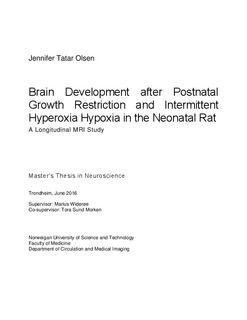| dc.description.abstract | Children born prematurely are commonly exposed to perinatal events such as infections, apneutic attacks and poor lung performance. These conditions put the children at risk of a reduced oxygen uptake and tissue hypoxia. Furthermore, overcompensations in treatment of hypoxia with supplementary oxygen often introduce too high levels of oxygen in the body, leading to tissue hyperoxia. The resultant periods of intermittent hyperoxia hypoxia (IHH) in preterms during critical periods of growth and development have been suggested to cause damage to white and grey matter in the brain, and to impair neurodevelopment. Body weight (BW) has also been suggested to play a role in the effects of IHH on brain development.
In this study we wanted to investigate the combined effect of IHH and postnatal weight gain on grey matter volume development in the brain. The purpose of this study was to increase the understanding of how a clinically relevant oxygen paradigm affects long term brain development, and possibly contribute towards improving the quality of the supplemental oxygen therapy that is provided to preterm born children.
Newborn rats were exposed to chronic levels of 50% O2 interrupted every three hours by three consecutive five-minute episodes of 12% O2, each eleven minutes apart, for the first two postnatal weeks. Postnatal growth restriction was obtained by litter culling, where litters consisted of either 8, 12 or 16 animals. T2-weighted magnetic resonance images were acquired at postnatal day (P) 15 and P28, together with BW. Volumes of various grey matter structures were measured.
Animals that had been exposed to IHH were found to have higher BWs and brain volumes compared to RA controls, suggesting that IHH had a positive effect on postnatal weight gain and volume increase. The study was unable to determine if the increase in brain volume resulted from positive growth or pathological processes such as edema. However, the general promotion of IHH on postnatal growth led to the conclusion that exposure to IHH most likely increased BW, and that the increase in BW again led to the increase in brain volume. | nb_NO |
